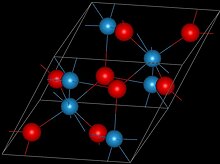Tungsten(IV) oxide is the chemical compound with the formula WO2. The bronze-colored solid crystallizes in a monoclinic cell.[1] The rutile-like structure features distorted octahedral WO6 centers with alternate short W–W bonds (248 pm).[1] Each tungsten center has the d2 configuration, which gives the material a high electrical conductivity.

| |
| Names | |
|---|---|
| Other names
Tungsten dioxide
| |
| Identifiers | |
3D model (JSmol)
|
|
| ECHA InfoCard | 100.031.662 |
| EC Number |
|
PubChem CID
|
|
| UNII | |
CompTox Dashboard (EPA)
|
|
| |
| |
| Properties | |
| WO2 | |
| Molar mass | 215.839 g/mol |
| Appearance | Bronze solid |
| Density | 10.8 g/cm3 |
| Melting point | 1,474 °C (2,685 °F; 1,747 K) from doi: 10.1007/BF02877593, decomposes at 1700 ◦C |
| Negligible | |
| 5.7×10−5 cm3/mol | |
| Structure | |
| Distorted rutile, (monoclinic), mP12, space group P21/c, no 14 | |
| Hazards | |
| Flash point | Non-flammable |
| Related compounds | |
Other anions
|
Tungsten disulfide |
Other cations
|
Chromium(IV) oxide Molybdenum(IV) oxide |
| Tungsten(III) oxide Tungsten(VI) oxide | |
Except where otherwise noted, data are given for materials in their standard state (at 25 °C [77 °F], 100 kPa).
| |
WO2 is prepared by reduction of WO3 with tungsten powder over the course of 40 hours at 900 °C. An intermediate in this reaction is the partially reduced, mixed valence species W18O49.
- 2 WO3 + W → 3 WO2
The molybdenum analogue MoO2 is prepared similarly. Single crystals are obtained by chemical transport technique using iodine. Iodine transports the WO2 in the form of the volatile species WO2I2.[2][3]
References
edit- ^ a b Wells, A. F. (1984), Structural Inorganic Chemistry (5th ed.), Oxford: Clarendon Press, ISBN 0-19-855370-6
- ^ Conroy, L. E.; Ben-Dor, L. (1995). "Molybdenum(IV) Oxide and Tungsten(IV) Oxide Single Crystals". Inorganic Syntheses. Inorganic Syntheses. Vol. 30. pp. 105–07. doi:10.1002/9780470132616.ch21. ISBN 978-0-470-13261-6.
- ^ Rogers, D. B.; Butler, S. R.; Shannon, R. D. (1972). "Single Crystals of Transition-Metal Dioxides". Inorganic Syntheses. Inorganic Syntheses. Vol. XIII. pp. 135–145. doi:10.1002/9780470132449.ch27. ISBN 978-0-470-13244-9.